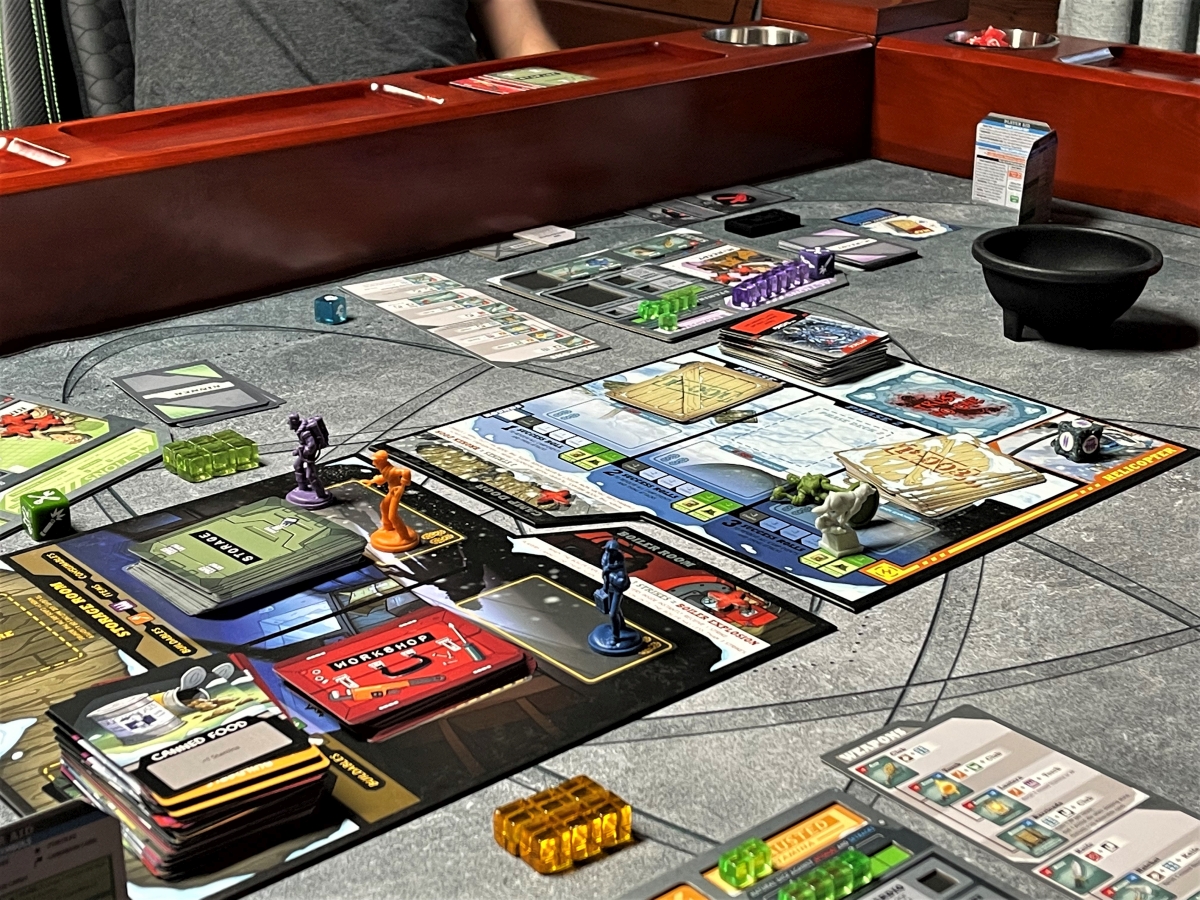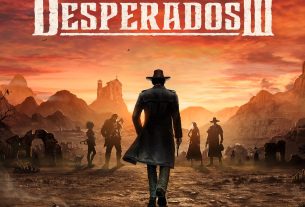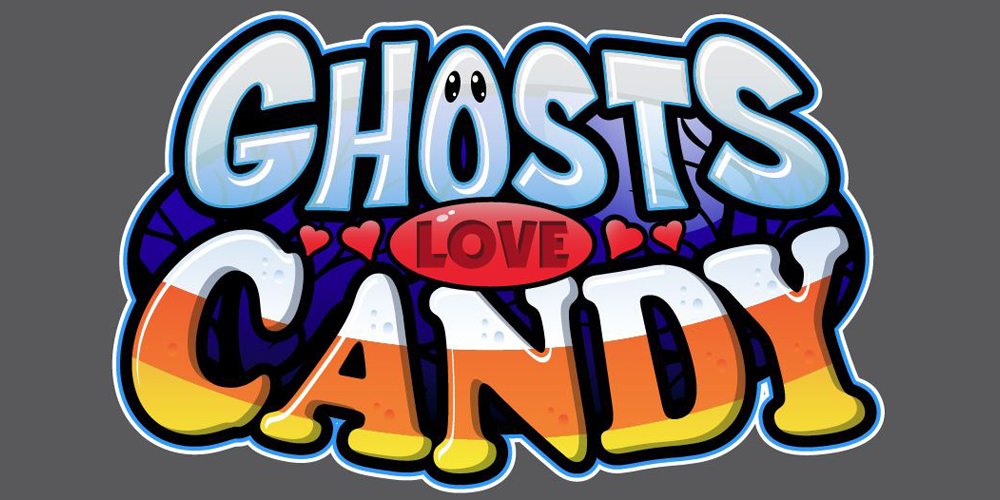Based off the 1938 John W. Campbell novella of the same name, Who Goes There? has you playing scientists and staff who are trapped at an Antarctic research station with a shapeshifting alien monster that can assume the identity of any person or animal it assimilates. If that sounds familiar to you, then you may know Who Goes There? better as its cinematic adaptations, 1951’s The Thing From Another World and 1982’s John Carpenter’s The Thing.
In the board game, you are trying to survive until you can escape the doomed station in a helicopter… hopefully without an extraterrestrial hitchhiker onboard!
What Is Who Goes There?
Who Goes There? is a card drafting, cooperative game with a traitor mechanic. It’s for 3-4 players (or 3-6 players with expansions), ages 14 and up, and takes about 3-4 hours to play. It does play better at higher player counts; 5-6 is optimal. This is the 2nd edition of the game, which recently shipped out to backers of the Kickstarter campaign. You can purchase a copy of the base game, the “Base Camp” edition, for $75 at Certifiable Studios’ webstore. There is also a “Deluxe, Deluxe” edition with an additional 8 playable characters and components for $150.
Who Goes There? was designed by Anthony Coffey and Jesse Labbe and published by Certifiable Studios, with illustrations by Anthony Coffey and Jesse Labbe.
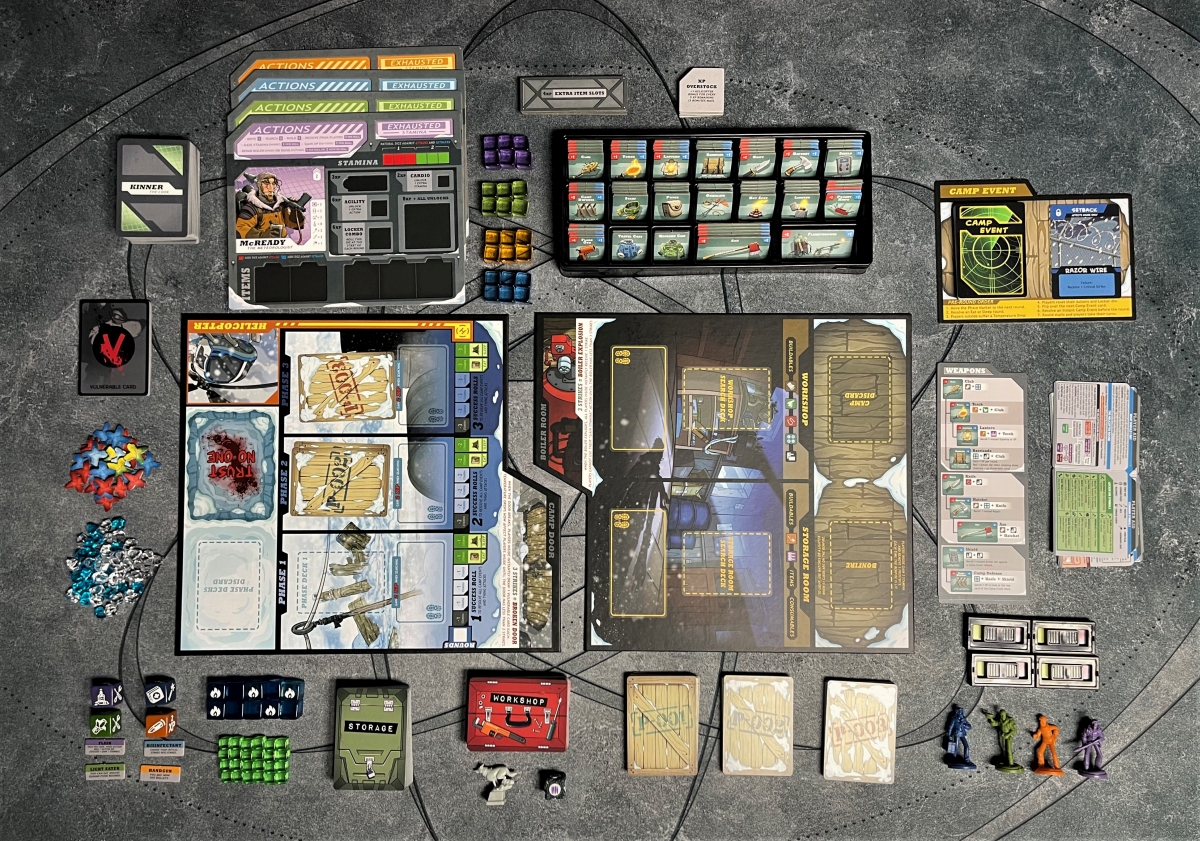
Who Goes There? Components
Certifiable Studios sent me the “Deluxe, Deluxe” edition of the game. Pictured above is everything that would come in the “Base Camp” edition, and is enough to play the game with up to 4 players. The “Deluxe, Deluxe” comes with all of that, plus everything from four different 2-player character expansions, each of which is also available separately. Inside the “Deluxe, Deluxe” box, there are 2 separate inserts. The top insert, along with the Game Board, holds all of the components for the base game, while the bottom insert holds all of the components for the expansions.
Here’s what’s in the base game:
- 1 Phase Marker Mini
- 2 Camp Boards
- 4 Infection Clickers
- 4 Player Aids
- 4 Build Menus
- 54 Workshop Cards
- 58 Storage Cards
- 75 Phase Cards
- 12 Vulnerable Cards
- 25 Camp Event Cards
- 80 Character Specialty Cards
- 4 Character Minis
- 2 Camp Boards
- 10 Action Dice
- 24 Stamina Cubes
- 24 Action Cubes
- 4 Character Boards
- 4 Locker Dice
- 95 Item Tiles
- 1 Tile Tray
- 28 Strike Tokens
- 50 XP Gems
- 1 Helicopter Die
The deluxe box adds the following:
- 9 Character Minis
- 8 Character Boards
- 8 Locker Dice
- 160 Character Specialty Cards
- 12 Stamina Cubes
- 48 Action Cubes
- 2 Player Aids
- 2 Build Menus
- 2 Infection Clickers
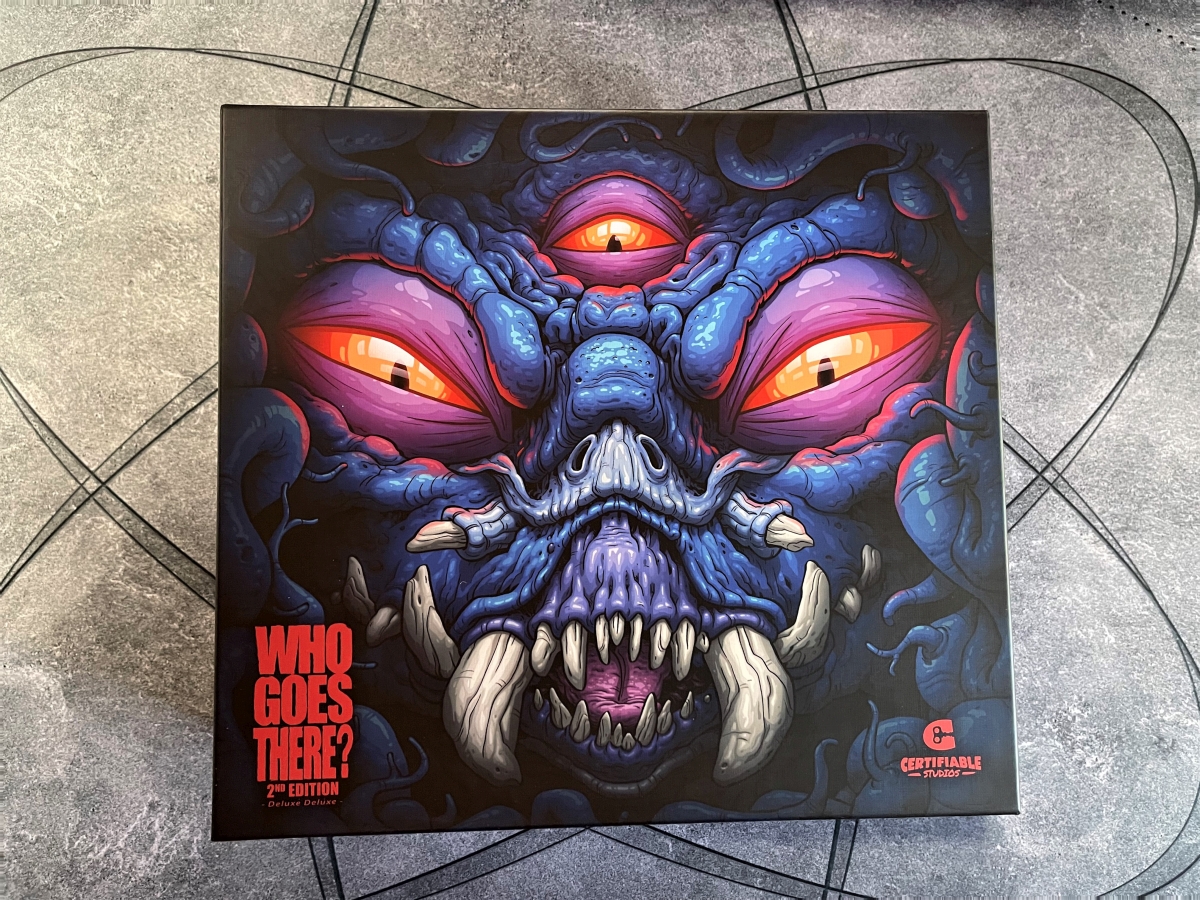
Both the “Deluxe, Deluxe” and “Base Camp” editions come with box art very similar to that shown in the picture at the top of this page. However, with the “Deluxe, Deluxe” edition, you also have the option of getting alternate artwork depicting The Thing. And while the “Deluxe, Deluxe” box is rather large, board gamers will be happy to know that both of the 2nd edition boxes fit on a Kallax.

The two Camp Boards include spots to place your miniatures and cards, as well as the Phase Meter. There is also clear iconography used on the boards to remind you of what you can find at the different areas of the boards. The Camp Boards are made of heavy cardboard, and the illustrations are atmospheric but don’t distract from the gameplay.

All the Character boards are dual-layer cardboard, allowing you to slot in Action and Stamina cubes, as well as cardboard Item tiles and Player Specialty tiles. The graphic design thematically links the Character boards to the Camp boards, with layers of snow built up on the “ledges” and bottoms of those boards. There is a lot of information on the Character boards, but it is presented in a way that’s easy to see and understand. Even though players each have a detailed Player Aid, having so much information on the boards keep players from having to look up rules very often. Next to each character’s portrait are symbols for what types of cards, and how many, are in each character’s Specialty deck. This is another handy reference, and extremely useful for when you’re hoping to draw a particular card.

Speaking of those Player Aids, each player will have a double-sided folding reference sheet that covers all of the major rules. This is also especially helpful for when players may have become infected. After all, there’s nothing that says, “I’m the Thing!” like reaching for the rulebook immediately after they may have actually become The Thing.
While this is not what one would consider a miniatures game, there are some very nicely realized character miniatures that come with the game. These are sculpted in the same cartoon style as the artwork, and each come in a color that not only matches their Character boards, but also the Action cubes for each character. Here are the ones from the main game:
There is also a Phase Marker in the form of a running sled dog. If you’ve seen John Carpenter’s The Thing, that’s a sight very familiar from the start of the film.

The components are all of consistently high quality in the game. Action and Stamina cubes are plastic, while many of the tokens are thick cardboard. Each character will also have a unique Locker Die, which can be unlocked by spending XP, and then provides additional benefits each turn based on the individual character’s particular die. These are also colored to match each particular character.

There are 10 custom translucent Action dice included in the game for determining the outcome of events like attacks and setbacks. These have 3 sides with fire on them for successes, and 3 blank sides for misses. There is also one more custom die in the game, the Helicopter die, which is used in the final round of the game.
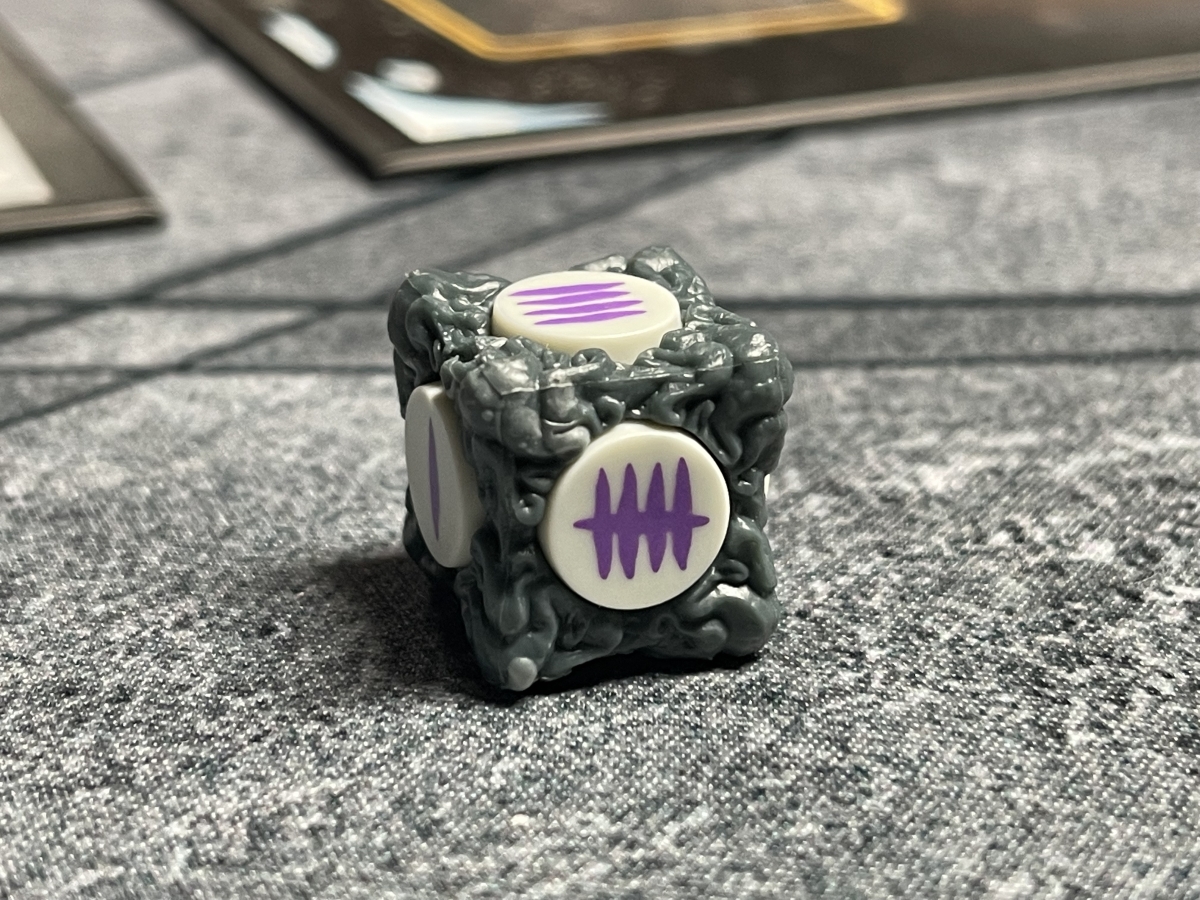
Each player will also have a Build Menu, which shows you which cards you will need to combine to build different items, as well as what those items do.

Once an item is built, you’ll draw the matching item tile from the Item Tray and slot it onto your Character board. Characters start with two free slots on their boards to place items, and can also pay XP to unlock additional slots.

Some items will add dice when rolling for attacks and/or setbacks, as indicated in the upper corners of the item tiles. The Workshop deck contains most of the cards that you will combine to make the different items:

There are different times during the game where players might become infected by another player who is secretly The Thing. I’ll discuss this in more detail in the “How to Play” section below, but in the meanwhile, here are the devices that players will exchange: Infection Clickers, which can be set to either show a green “clean” status, or a mottled “infection” status. As these audibly click into position, the Infection Clickers also help to ratchet up the tension.

Of special note are the plastic inserts. Certifiable Studios has designed both the base and deluxe edition inserts to not only store everything, but also to organize the game, making it quick and easy to set up and break down. Not only that, but when everything is back inside the box with the lid on, the contents are all secure and you can store the box horizontally or vertically without worry that you’re going to end up with a big mess. Here’s the bottom tray from the “Deluxe, Deluxe” edition, with the expansion character boards removed:

And here is a closer look at the expansion characters, available in the “Deluxe, Deluxe” edition or in separate two-packs:

Clark, the dog handler, even gets a dog miniature that joins him once he spends the XP to unlock his companion:

Altogether, the components are of the highest quality, which you would hope considering the price point. If anything, it’s slightly overproduced: each character has their own set of Action cubes in colors matching their characters, which is a nice touch but unnecessary mechanically as you can only play with a maximum of 6 Characters at a time. As Action Cubes are never shared, six sets of 6 in a generic color would have been sufficient for the game. I also really enjoy the stylized look to the game, which definitely makes it stand out from the crowd of other horror-themed board games.
How to Play Who Goes there?
You can download a copy of the rulebook here.
The Goal
The goal of Who Goes There is to stay human, stay alive, and escape on the helicopter while leaving The Thing behind.

Setup
Position the two Camp Boards facing each other in the center of the table. Create stockpiles of XP tokens and Strike tokens. Place the Tile Token Tray near the boards.
Place the Phase Marker at the start of the Phase Meter, and the Helicopter Die on the Helicopter Space on the Outside Camp Board.
Shuffle the Storage and Workshop decks and place them on their spots on the Inside Camp Board.

Shuffle the 3 Phase Decks, and place them on their matching spots on the Outside Camp Board. Take the top 5 cards from each Phase Deck, and place those cards facedown on the Phase Deck Discard space. Then shuffle the Vulnerable deck and place it on the “Trust No One” space.

Place the Camp Event board next to whoever is playing the Team Leader. Shuffle the Event Deck and place it on its space on the board.
Each player chooses a character, and takes their Character Board, and matching miniature, Specialty deck, Locker Die, and Action Cubes. Place 5 Action Cube in the Actions tray, and the 6th cube in the “Agility” unlock slot.

Place 3 of the green Stamina cubes in the Stamina bar. Place 1 Stamina cube in the Cardio Unlock slot, and 2 in the Exhausted Stamina tray. Place the character’s Locker Die in the Locker Combo slot, with their character attribute facing up.
Each player gets a Build Menu and Infection Clicker. Shuffle the character’s Specialty Deck and place it next to the Character Board.
Gameplay
An important note: everyone is human at the beginning of the game.
Whichever character has the highest rank will be the Team Leader for the game. The Team Leader determines what order players will take their turns each round, manages Camp Events, and controls the voting during the Helicopter Round.
Beginning the Game
After setup is complete and the Team Leader has established the turn order for the first round, each player will, in turn order, draw 1 card each from the Storage, Workshop, and their personal Specialty decks. Each player will choose a starting space (note that only the Phase 1 space is unlocked on the Outdoor Camp Board at the start of the game). Then the Team Leader will start the game.
Pre-Round Sequence
Before every round the Team Leader will repeat the following sequence:
- Move the Phase Marker to the next round.
- If it is a Food or Sleep round, resolve the requirements of the round.
- Outside players suffer a Temperature Drop, resulting in a loss of stamina.
- Each player resets their Action cubes and, if unlocked, their Locker Die.
- Flip over the next Camp Event card.
- Resolve any Instant Camp Event.
- Players take their turns in the order established by the Team Leader.
Camp events will often have each player rolling dice on their turn to see if they succeed or fail the event. If a player forgets to resolve the Camp Event on their turn, they automatically take the failure penalty.
Food and Sleep Rounds
These special rounds, which occur 3 times during the game, can potentially cause players to become infected. Here’s how they work:
During a Food round, players must play a Canned Food card during the Pre-Round sequence or draw a Vulnerable card. There are 12 cards in the Vulnerable deck, with only 1 “Infected” card. Note: whenever a player draws a vulnerable card, they do not reveal what card they have received.

During a Sleep round, players must bunk in pairs, and be in the same location (i.e., on the same Camp Board). Any player that either can’t sleep alone, or chooses not to, must draw a Vulnerable card. If a player is sleeping with a character that already has a Vulnerable card, then they must receive that player’s Infection Clicker and secretly look at the status of the clicker. If the status is showing infected, then that player is now also infected. It should be noted that an infected player is never required to infect another player, and can choose to show the green “not infected” status to the other player.
Game Rounds
After the Pre-Round sequence, each player will take their turns. On each turn, a player can take as many regular actions as they have Action Cubes available to spend, plus an unlimited number of free actions.
Regular Actions
- Trade: Spend 1 Action Cube to receive any number of cards from another player in your same location. If trading with someone that has a Vulnerable card, you must receive that person’s infection clicker unless you roll a success on an Action die.
- Move: Spend 1 Action Cube to move to any available space. You may only move from one Location (Camp Board) to another once on your turn.
- Search: Spend 2 Action Cubes to draw a card from either the deck of the space that you are in, or from your Specialty deck if you are indoors. Phase decks, which are outdoors, contain some valuable cards like Helicopter Bonuses (which you will need for the final round of the game) but also contain Thing attacks.

Searching any of the Phase Decks also grants you 2XP. These are gems that you can spend any time on your turn to unlock abilities on your Character Board.

- Build: Spend 1 Action Cube to build an Item tile, discarding any cards used for the build. This may only be done inside.
- Gain Stamina: If you are inside, you may spend 1 Action Cube to roll an Action die. On a success, you move 1 Stamina cube from the Exhausted tray to your Stamina Bar. How many cubes you have in your Stamina Bar will determine how many Action dice you will roll (in addition to any that items may grant you).
- Gain XP: If you are outside, you may spend 1 Action Cube to roll an Action die. On a success, gain 1 XP.
- Repair: Certain Events and Phase cards can cause damage to either the Boiler Room or the Camp Door. If either of those take 3 Strikes, then it’s bad for the players. You can repair the Boiler Room when inside, or the Camp Door when outside, by spending 2 Action Cubes and removing a Strike. You alternately can spend 1 Action Cube and roll and Action die; on a success you will also remove a Strike. You will also gain 1 XP when successfully repairing.
- Player Assault: You can spend 5 Action Cubes to attack another player in the same location.
Free Actions
- Play any cards from your hand to gain their benefit.
- Add cards facedown to the Bonfire. You must be indoors.
- Light Bonfire: Once there are 5 cards in the Bonfire space, a player with matches or a lighter can light the Bonfire, restoring stamina and removing frostbite from any characters that are indoors.
Strikes and Frostbite
There are different times that players will receive Strikes during the game.

Strikes can be removed by playing a First Aid card. Critical Strikes, if they are not healed before the end of a player’s turn, generate a 2nd Strike.
Any time that you receive 3 Strikes you are rendered unconscious, and must be revived by another player. For every turn that a player is not revived, they skip a turn and one of the strikes is flipped over and becomes Frostbite, which may only be removed by the Bonfire. If a player ever has 3 Frostbite tokens, then they are dead and out of the game. Note: dead players do not reveal their infection status until the end of the game.
The Thing and Infection
There are several times that a person can become infected by The Thing. The primary one is by drawing a Vulnerable card which has the “infected” symbol, which makes that player the Host for The Thing. In addition, there are several times when Infection Clickers are exchanged between players. Those are opportunities for a Host to infect another player.
These are the situations when, if someone is infected, that they can choose to infect the other player:
- Sleep Round. Anyone bunking with another player that has a Vulnerable card must pass their Infection Clicker to that other player.
- Trading: Anyone that has a Vulnerable card must pass their Infection Clicker with the person they’re passing cards to. The receiver of the trade may roll a die to prevent having to take the clicker.
- Revive: If you are reviving another player and have a Vulnerable card, you must pass your Infection Clicker to that person.
With Dr. Copper’s Blood Test card, or a buildable Host Test, both the person performing the test and the player that they are performing it on must exchange Infection Clickers, honestly revealing their infection status to each other. This does not spread the infection.
There is one additional way that someone that the Host (the only player with the “infected” Vulnerable card) can attempt to spread the infection: Through an infection attack. Much like with a Player Assault action, the Host spends 5 Action Cubes, and can target as many other players in their location as they have “clean” Vulnerable cards. To do the attack, they take their “infected” card, and those “clean” cards, shuffle them together, then each of the targeted players draws a facedown card. If one of them draws the “infected” card, then you have spread the infection, and they are the new Host.
Game End
The final round of the game is the Helicopter Round. This round determines who, if anyone, wins the game. These are the steps taken during the final round:
- Team Leader Vote: Everyone that is alive at the end of the game votes to decide if they want to keep the current Team Leader. If they are voted out, then the next player in rank becomes the new Team Leader, and another vote is taken. This process continues until a successful vote.
- Boarding Process: Players debate as to who they trust to go onto the helicopter, but ultimately the Team Leader is the one who will make the final decision. The Team Leader can even decide to leave by themselves. Humans are trying to leave with just other humans, while those that are infected are trying to leave with at least one human.
- The Reveal: Once the Team Leader has decided who is going on the helicopter, everyone takes their Infection Clickers and reveals their Infection status. If everyone is infected, then the game is immediately lost by all.
- Determining Win/Loss: Both Human and Infected players calculate their bonuses, based on adding their Helicopter Bonus cards, XP Overstock, and the result of rolling the Helicopter Die. Subtract the Infected bonuses from the Human bonuses, and compare it with the Escape Threshold (# of human characters total at end of game times 6).
If the final number is greater than the Escape Threshold, the humans win. If the number is lower, the Thing wins.

Why You Should Play Who Goes There?
I really enjoyed playing Who Goes There? But then again, I’m also a bit of a target audience for the game. John Carpenter’s The Thing is one of my all-time favorite horror films, and I also happen to enjoy hidden traitor games. But Who Goes There? is not exactly a hidden traitor game, even though there will certainly be at least one person infected over the course of the game, if not a few. But you’re not actively working against the other players, such as in the classic hidden traitor game, Battlestar Galactica. If anything, if you’re infected, you want to behave just like a human. After all, your goal as The Thing is to get onto the helicopter at the end of the game, so you can go forth to spread the infection globally.
As Certifiable Studios themselves state, this is “a suspenseful game of co-op, strategy, and growing paranoia.” The moment one person has to draw a Vulnerable card, suspicions start to build… even though, early in the game, there’s only a one in twelve chance that someone has drawn the 1 “infected” card in the deck.
Who Goes There? is not going to be a game for everyone. For one, not everyone likes hidden traitor mechanics in their co-op games. It’s also a relatively long game, taking several hours to play out, and that length can even be extended to create more of a challenge. And finally, there are some people that hate that their fate could rest on a single roll of the Helicopter die. Though, if you’ve been accumulating Helicopter Bonus cards and bonus XP throughout the game, that definitely helps mitigate the randomness of the roll.
However, if you’re someone who enjoys the journey more than whether you win or lose, Who Goes There? is a very enjoyable game that you’ll have a great time playing with like-minded friends and family. Even if my gambit in that game hadn’t paid off, watching my friend Ray’s head practically explode trying to figure out whether I’d managed to infect Chris was a delightful climax to our game. And, to be fair, at that point all I knew is that I had infected either Chris or Ray. For all I knew, Ray’s sudden consternation could have been an act. And discovering at the end that Chris had infected Jason too, and that the two of them had managed to convince Ray to take them both onto the helicopter with him, was the delicious cherry on top.
For more information or to purchase Who Goes There?, check out Certifiable Studios’ Who Goes There? page!
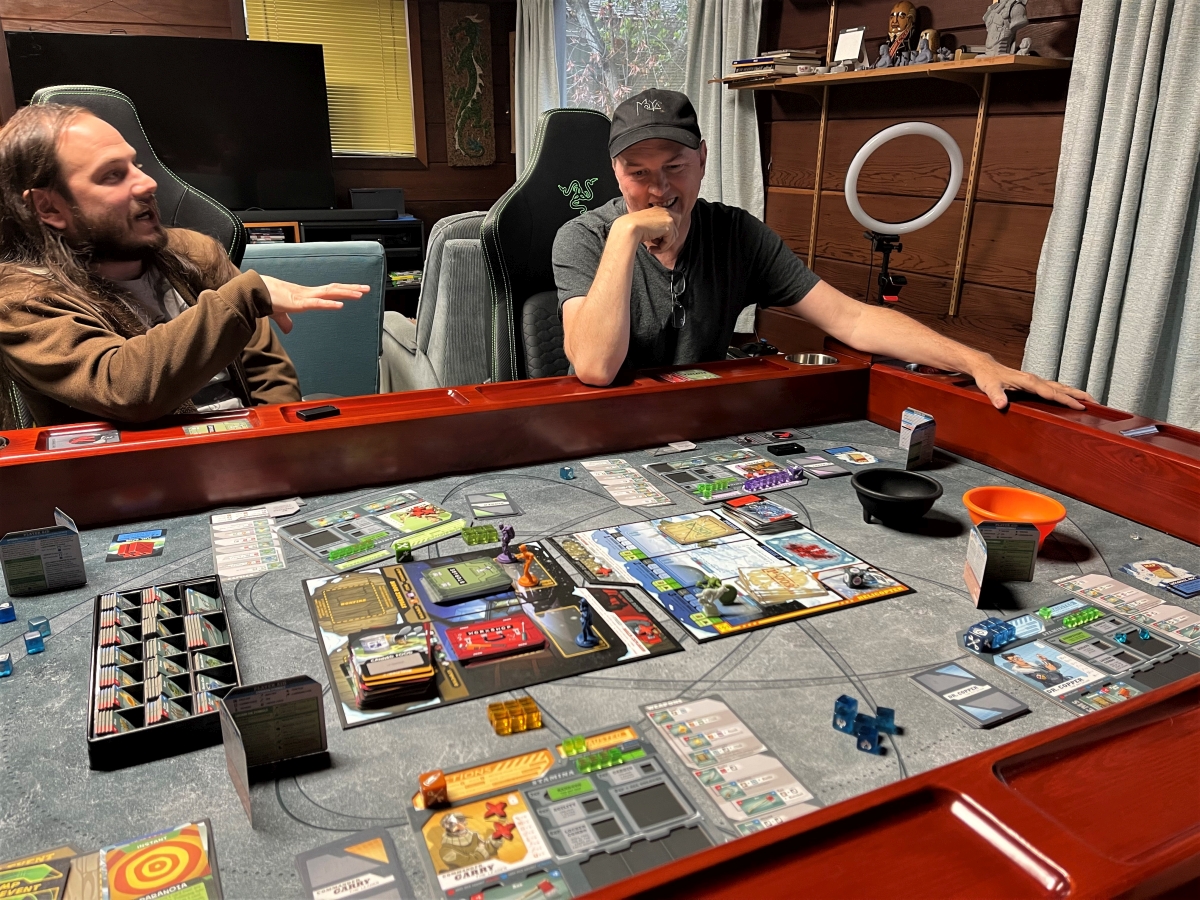
Click here to see all our tabletop game reviews.
![]() To subscribe to GeekDad’s tabletop gaming coverage, please copy this link and add it to your RSS reader.
To subscribe to GeekDad’s tabletop gaming coverage, please copy this link and add it to your RSS reader.
Disclosure: GeekDad received a copy of this game for review purposes.

